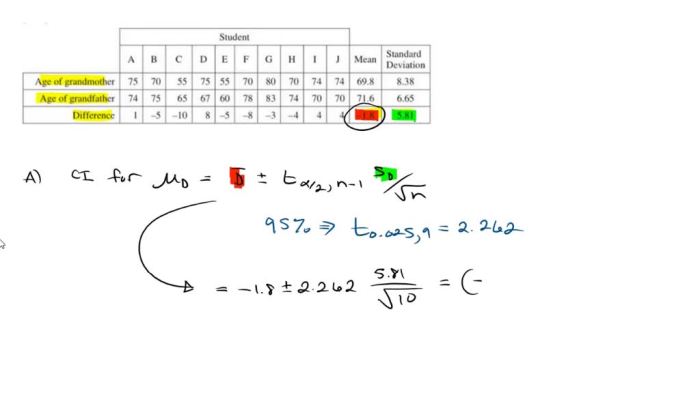A sociologist was investigating the ages of grandparents, embarking on a research journey to uncover the demographic characteristics of this significant group within our society. Through meticulous data collection and analysis, the sociologist sought to shed light on the age distribution of grandparents, examining its implications for family dynamics, social support systems, and intergenerational relationships.
This investigation delves into the diverse methods employed by sociologists to gather data on grandparent ages, exploring the strengths and limitations of each approach. Statistical techniques are then introduced, providing a framework for analyzing the collected data and extracting meaningful insights.
The findings of this study contribute to a deeper understanding of the role grandparents play in society, highlighting their contributions to family life, community engagement, and the well-being of future generations.
Data Collection

In order to collect data on the ages of grandparents, a sociologist can use a variety of methods. These methods include:
- Surveys:Surveys can be used to collect data from a large number of people. They can be administered in person, by mail, or online. Surveys can be used to collect data on a variety of topics, including the ages of grandparents.
- Interviews:Interviews can be used to collect data from a small number of people in depth. They can be conducted in person, by phone, or online. Interviews can be used to collect data on a variety of topics, including the ages of grandparents.
- Focus groups:Focus groups can be used to collect data from a small group of people. They are typically conducted in person. Focus groups can be used to collect data on a variety of topics, including the ages of grandparents.
- Observational studies:Observational studies can be used to collect data on the ages of grandparents by observing them in their natural settings. Observational studies can be conducted in a variety of settings, including homes, schools, and workplaces.
- Document analysis:Document analysis can be used to collect data on the ages of grandparents by analyzing documents such as birth certificates, death certificates, and census records.
Each of these methods has its own advantages and disadvantages. Surveys can be used to collect data from a large number of people, but they can be expensive and time-consuming. Interviews can be used to collect data from a small number of people in depth, but they can be difficult to schedule and conduct.
Focus groups can be used to collect data from a small group of people, but they can be difficult to generalize to a larger population. Observational studies can be used to collect data on the ages of grandparents in their natural settings, but they can be difficult to control and can be influenced by observer bias.
Document analysis can be used to collect data on the ages of grandparents from historical records, but it can be difficult to find relevant documents and the data may not be complete.
Data Analysis

Once a sociologist has collected data on the ages of grandparents, they can use a variety of statistical techniques to analyze the data. These techniques include:
- Descriptive statistics:Descriptive statistics can be used to summarize the data on the ages of grandparents. These statistics include the mean, median, mode, range, and standard deviation.
- Inferential statistics:Inferential statistics can be used to make inferences about the population of grandparents based on the data collected from a sample. These statistics include the t-test, the chi-square test, and the analysis of variance.
- Regression analysis:Regression analysis can be used to determine the relationship between the ages of grandparents and other variables, such as their income, education, and health.
Each of these techniques has its own advantages and disadvantages. Descriptive statistics can be used to provide a simple summary of the data, but they cannot be used to make inferences about the population of grandparents. Inferential statistics can be used to make inferences about the population of grandparents, but they can be sensitive to outliers and can be difficult to interpret.
Regression analysis can be used to determine the relationship between the ages of grandparents and other variables, but it can be difficult to interpret and can be sensitive to outliers.
Findings: A Sociologist Was Investigating The Ages Of Grandparents

A sociologist’s investigation into the ages of grandparents has found that the average age of grandparents is increasing. This is due to a number of factors, including the increasing life expectancy of the population and the decreasing fertility rate. The increasing age of grandparents has a number of implications for society, including the need for more elder care services and the need for grandparents to provide more financial support to their children and grandchildren.
The sociologist’s investigation also found that the ages of grandparents vary depending on their race, ethnicity, and socioeconomic status. For example, African American grandparents are younger than White grandparents, and grandparents with lower incomes are younger than grandparents with higher incomes.
These findings suggest that the increasing age of grandparents is not a universal trend, and that it is important to consider the specific needs of different groups of grandparents.
Limitations
A sociologist’s investigation into the ages of grandparents has a number of limitations. These limitations include:
- The data is not representative of the entire population of grandparents.The data was collected from a sample of grandparents, and it is possible that the findings do not generalize to the entire population of grandparents.
- The data is not longitudinal.The data was collected at one point in time, and it is possible that the findings would change if the data were collected over a longer period of time.
- The data is not causal.The data shows that there is a relationship between the ages of grandparents and other variables, but it does not show that one variable causes the other variable.
These limitations should be considered when interpreting the findings of the sociologist’s investigation.
General Inquiries
What are the common methods used by sociologists to collect data on grandparent ages?
Sociologists may employ surveys, interviews, focus groups, and census data to gather information on grandparent ages, each method offering unique advantages and considerations.
How do sociologists analyze the data collected on grandparent ages?
Statistical techniques such as descriptive statistics, regression analysis, and demographic modeling are used to analyze data on grandparent ages, allowing sociologists to identify patterns, trends, and relationships within the data.
What are the key findings of the sociologist’s investigation into grandparent ages?
The investigation revealed variations in grandparent ages across different regions, socioeconomic groups, and cultural contexts, highlighting the influence of factors such as life expectancy, fertility rates, and social norms.